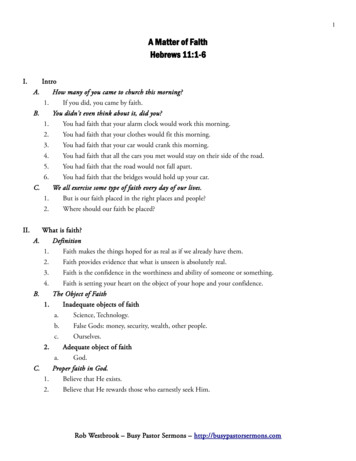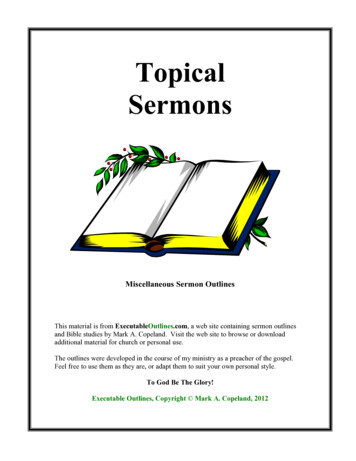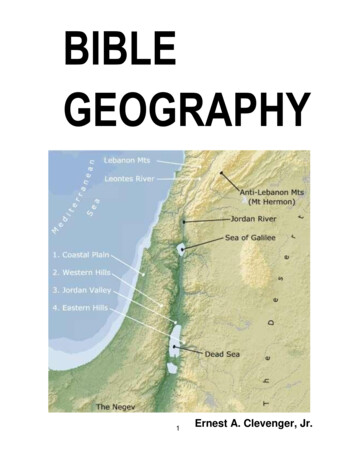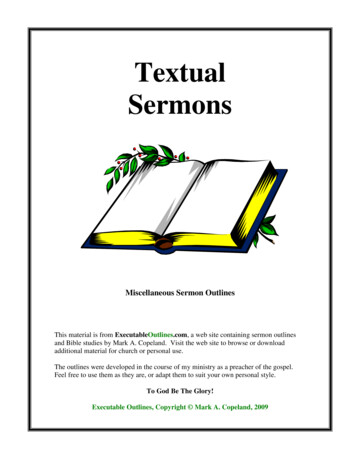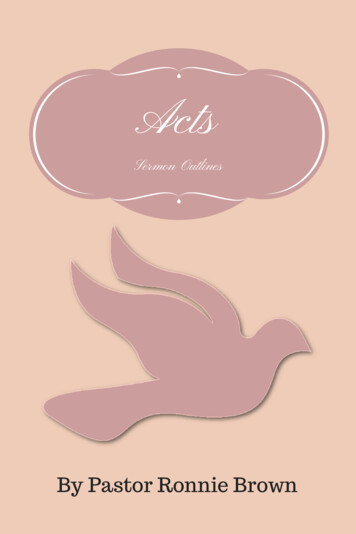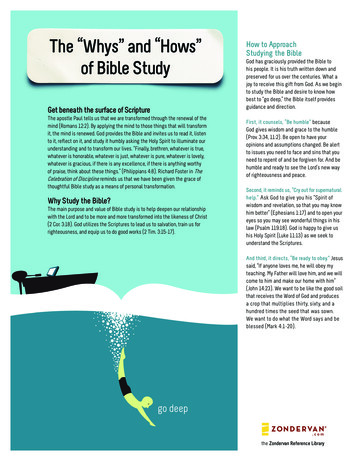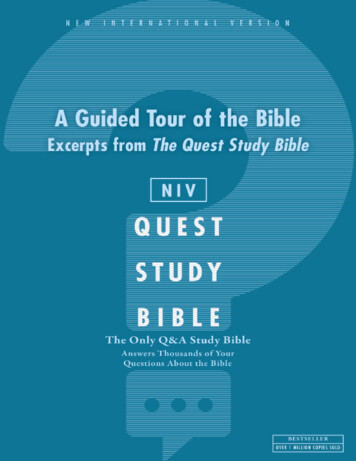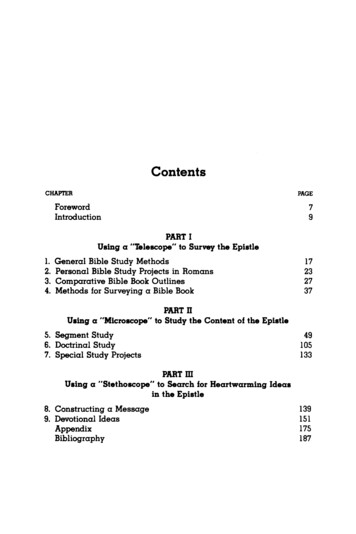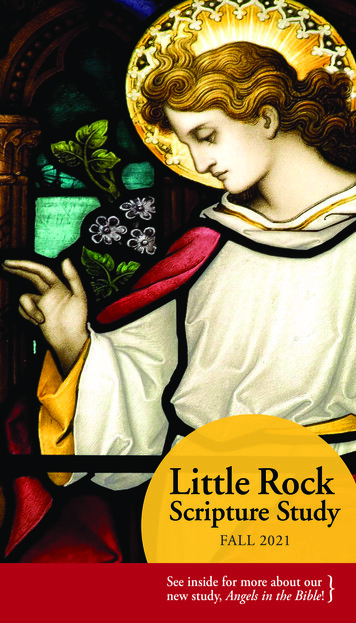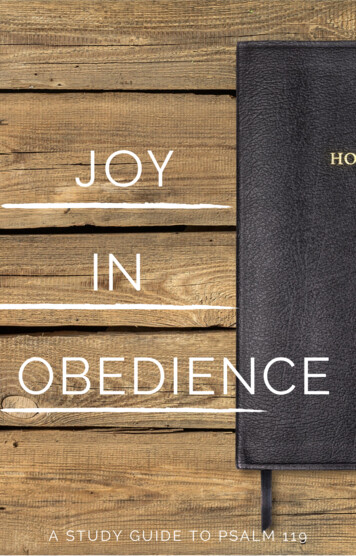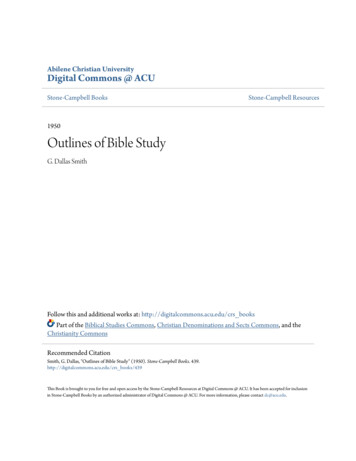
Transcription
Abilene Christian UniversityDigital Commons @ ACUStone-Campbell BooksStone-Campbell Resources1950Outlines of Bible StudyG. Dallas SmithFollow this and additional works at: http://digitalcommons.acu.edu/crs booksPart of the Biblical Studies Commons, Christian Denominations and Sects Commons, and theChristianity CommonsRecommended CitationSmith, G. Dallas, "Outlines of Bible Study" (1950). Stone-Campbell Books. 439.http://digitalcommons.acu.edu/crs books/439This Book is brought to you for free and open access by the Stone-Campbell Resources at Digital Commons @ ACU. It has been accepted for inclusionin Stone-Campbell Books by an authorized administrator of Digital Commons @ ACU. For more information, please contact dc@acu.edu.
G. Dallas Smith
Outlines of Bible StudyFOR USE INQIBLE DRILLS, BIBLE READINGS, BIBLECLASSES, PRAYER MEETINGS,AND HOME STUDY(Revbed and Enl al"ll'ed)BYG. DALLASSMITHMurfree sboro, Teaa.* * *Order From :A . C. C. Students' Exchang eStatio n AAbil ene, Texas
PREFACEOutlines of Bible Study is not a commentary in any senseof the word. It contains but few comments. It is not" literature" in the sense in which many object to literature.It docs not study the lessons for you, but rather guides youin an intelligent study of the Bible itself. It is just what itsname implie s-outlin es of Bible study. It simply outlinesyour Bible study, making it possible for you to study it systematically and profitabl y.The questions following e!lch outline direct the student,with but few exceptions to the Bible itself for his answers.This forces him to "search the Scriptures" diligently tofind answers to the questions, and leaves him free to framehis answers in his own language. In the very nature ofthings, this little book can never take the place of the Biblein class work; for it is absolut ely useless and worthless with out the Bible, to which it constantly directs the student.You do not study this little book, except to familiariz e your self with the plan of study; but you study the Bible itself,this little book serving you only as a guide in your study.The author has spent many hours very pleasantly andprofitably in the preparation of this work. He has alsotaught the .::oursesoutlined in th e following pages for a number of years with quite a degree of satisfaction. And it ishis sincere desire that many others may find both pleasureand profit in the study of the one great Book as herein outlined.Th is little book is now sent forth on its mission, which isto lead men to sy;;ternaticall y stud y the one Book, with theearn est prayer that it may accomplish its mi ssion whereverit goes.THE AUTHOR.
A WORD TO TEACHERS AND STUDENTSBefore you undertake to study or to teach the Bible bythis system of outlin es, be sure you understand the plan thoroughly. It is a beautiful sysk m, easily understood, and willproduce results if faitl1fully followed.You will notice that there are seventeen drill lessons running through the book and covering all Bible history. Thesedrills ( except the first and the second) corn,ist each of anoutline, followed by a series of questions and answers, or r eferences for answers . The first drill has no outline, but issimply a list of questions and answers. This introductorylesson is intended to furni sh the student information aboutthe Bible as a book before he begins to search within for itswonders. The second drill has no outline, but consii:its of adiagram of the historical pcrioc.1s of the Bible, followed by alist of questions which lead to a careful stud y of the diagram.This lesson is intended to "blaze the way," so to speak,throu gh the Bible, and give the studen t an illea of the groundto be covered and the work to be done in the following fifteen drills.The outlines of the :fifteen periods are necessarily verybrief, and are intend ed to suggest to the student, at sight,the ground to be covered under each particular period.'rhe se outlines should be carefully studied before proceedingto the list of questions which follows. To know th ese outlin es thoroughly gives one a general knowledge of the Bible,as to its divisions and subdivisions, and renders the study ofit both pleasant and profitable.The list of questions following each outline is intended todir ect the line of thought and study . The se questions do notexhaust the subject, of course. Many of these will suggest
OUTLINESOF BIBLFSTUDY5othEr questions which the wide-awake teacher will be sure t-0ask. In looking up references for answers tu questions, thestudent should not be safo;fied to read the verse or verses, oreven the! chapters indicated, but should l'ead the connectionsand marginal references and investigate each subject as thoroughly as possible.With a competent teacher, who knows his lesson well, andwho is capable of using the drill method efl'ectivdy, a classmay be carried over thi course in sevente en days-one drilleach day--witb good results. Of course, in this case, thesuccess will depend largely on the tead1er and his abilit y toimpart knowledge by drilling the class over and over againand again, on the principal points.But, for better results, it is advised that the course be covered in seventeen weeks in stead of seventeen days. Thisgives more time for the stud ents to pr"pare the lessons, andis more satisfactory in every way. Of course, even in thisseventeen-weeks' course, much depends on the teacher andhis fitness for the work. However, almost any one with somenatural talent as a teacher can successfully conduct thisseventeen-weeks' course, if he will faithfully apply himself.But where it is desired to go more into details, and tostudy the lessons more car efully and critica lly, it is best togive one year's study to the course. For this purpose thequestions have been divided into fifty-two lessons, indicatedin parentheses. This furnish es a splendid year's work forstudents of almost any age. Any one with ordinary abilitycan teach this course successfully, as it gives the teacherplenty of time to familiarize himself with the lessons beforecoming before the class. This course is recommended for allweekly Bible classes, especially for students above twelve andfourteen years of age.The author of this little book has taught classes accordingto each of the plans suggested above, and is frank to say,
6OUTLINESOF BIBLESTUDYwithout appearing to boast, that the results have been, ineach case, quite gratifyin g. Of course, the more tim e thatcan be given to th e course, the better it is. But where acompetent teacher can be secured for only seventeen clays, hecan usually instill new life in to a congregation, even in thisshort time, and lead them to where they can continue thework pr ofitably.Each stud ent should be provided with some good referenceworks-a good En glish dictionar y, a Bible dicti onary or encyclopedia, a good B ible geography and concordance. Forstudy on D rill I. and Drill XV., "All About the Bible"(price, 1) and "B etween the Testament s" (price, 75 cents),by Flemin g H. Revell Company, Chicago, will be found veryvaluable.THE AUTHOR.
OUTLINESOF BIBLESTUDY'tDRILL I.-INTRODUOTION(Lesson 1-Introduction)1. What does the word "Bible" mean? It comes fromthe Greek word "biblos," which means "book," or from theGreek word "biblia," which means "books" or "littlebooks."2. Why was the name "Bible" applied to the sacred writings? By way of preeminenc e; it is "the Book of books."3. When was the name "Bible" first applied to these sacred writings? About the fourth century A.D. (? ) .4. Mention some scriptural nam es that are applied to thesewritings. Rom. 3: 2; 2 Tim. 3: 16, 17; 4: 1, 2.5. Define the word " c,criptures." The word literallymeans anything written; but " the Scriptures" has come tomean the inspired writings.6. Define the word " oracles." The word liforally meansutterances of God.7. How did God utter these "oracles?"2 Sam. 23: 2;Acts 1: 16; 2 Pet. 1: 20, 21.8. About how many men wrote the Bible? Betweenthirty six and forty.9. Why can we not t ell ju st how many? It is not certainas to who wrote some of the books.10. How many years were th ey writing, from first to last?About sixteen hundred yea.rs.11. State the numb er of years covered by their writings.In round numbers, about four thou sand.12. Are there any of these original writings now in existence? No.13. What do you know about ma.nuscript copies of the Bible? There are said to be some fifteen hundred copies, someconta;ning the whole Bible, and some of them dating as farback as the fourth century.14. Where a.re th ese manuscript copies? The " Vatican"is in the possession of the Roman Catholic Church at Rome;the "Sinaitic" is at St. P etersburg, in the possession of theGreek Catholic Church; the "Alexandrian" is in the Brit-
8OUTLINESOF BIBLESTUDYish Museum, the property of the Protestants.Each of theseThen there aremany copies in private libraries in different parts of the world.15. Name twenty Old Testament writers. Search theScriptures.16. How many books did :Moses write? :Moses wrote fivebooks-Genesis to Deuteronomy, and possibly Job.17. What are these five books called? They are calledth e "Pentateuch," from the Greek word "pentateuchos,"which means a fivefold book.18. Name all the New Testament writers . Search theScriptures.19. How many of the se were apostles? Search the Scriptures.20. Tell how many books each New Testament writerwrote. Search th e Scriptur es.21. In what language was the Old T estament originallywritten? Mainly in the Hebr ew.22. In what language was th e New T estament originallywritten? In the Greek language.23. When and where was th e Old Testament first translated into Greek? The work is said to have begun in theyear 277 B.C. in Alexandria, Egypt.24. What is this version of the Old T estament called? Itis called the "Septuagint," from the Latin word "septua ginta," which signifies seventy.25. Why was it callQll the " Septuagint?"Because it wasonce thought to have been translated by seventy-two scholarsin seventy-two days.2G. By what other name is thi s version called? It is calledthe "Alexandrian," because it was tran slat ed in Alexandria.27. Are there any copies of this version now in existence?Yes, and they are said to be th e oldest documents in existence.28. What evidence have we that th e Septuagin t version isauthentic? Scholars generally agree that it is th e versionfrom which Jesus so often quoted. If so, it has the approvalof the divine Son of God.29. Into about how many languages has the Bible beentran slated ? About five hurnlr r l. Some say six lmndr ed.30. What was Eugland's first Bible? The "V ulgate," athree contains nearly the whole of the Bible.
OUTLINESOF BIBLESTUDY9Latin translation made from th e Septuagint version of theOlcl Te stament and the ori ginal Greek of the N ew T estament.It comes31. What does th e word " V ulgate" mean?from th e Latin word "vulgata," which signifi es "to makecommon, or public."32. Who revised. this Vulgate version?Jerome, in thefourth century.·33. What do you know about this version of the Vulgate?It is the version that is still used by th e Catholic Chur ch.3-1. What was the first Engli sh tran slati on of note? Wyckliffe's translation from the Vul gat e in 13G0-1382.35. How long was Wyckliffe enga ged in tran slating theBible from the Latin into the Engli sh? He is said to h avespent twenty-two years on it.36. How long did it tak e to mak e a copy of this Bibl e witha.pen? It reqmred fon months.(Lesson 2-Introduction-Continued)1. How did these manu script copies of the Bible sell?They are said to have sold for about 200 a copy.2. Who opposed Wyckliffe in his work of translatin g theBible into the Engli sh langua ge ? The Roman CatholicChurch opposed him and pers ecut ed him. He was formallytried and excommunicat ed, and fort y years aft er his deaththey dug up his body and burn ed it and scatt ered his asheson th e Hiver Swift.3. Who gave us our first print ed En glish Bibl e ? WilliamTyndale , in 1525, print ed th e New T estament in En;di sh,and in 1536 Miles Coverd ale print ed the whole Bible in English .4. What do you know of thi s first print ed New T estam ent?It is now in th e Briti sh Museum.5. What became of William Tyndal e? He was mercil esslypc r secut ed by th e Rom an Catholi c Chu rch, and finall y, onOctober 6, 153G, he was strangled and th en burned at thesta ke.6. What was the first " Authori zed Vers ion " of the Bible ?In 1537 Jo hn Rogers issued a B ible under th e titl e of "Ma tt hew's Bib1e." 'l'wo years latr r Miles Coverdale an d othersbrought out what was p rac tically a repr int of "M att hew's
100UTL'INES OP BIBLE STUDYBible" under the title of " Cranmer's Bible." When 'KingHenry VIII. saw it, he said: "In God's name let it go forthamong our people." This was the first official authority forcirculating the Bible."I. By what other name was this Bible called?It wascalled the "Great Bible," because of its size, and also the" Chained Bible," because it was chained to the pulpits of thechurches for safe-keeping .8. What do you know of Henry VIII. lat er in life? Heafterwards ceased to encourage the circulation of the Bible,and in consequence the destr uction of Bibl es by the Catholicswas-grea t.9. What was the first distinctively Protestant Bible? The"Geneva Bible," which was publil:,hed by the Reformers inGeneva, whither they had fled during the awful persecutionin th e reign of Queen Mary, during whose -reign some threehundred Bible men were burned at the stake.10. Why was this Bible called the "Br eeches Bible?"Because Gen. 3: 7 was r endered: "They sewed fig tree leaves together and made themselv es breeches."11. ·what else do you know about this Geneva Bible? Itwas th e first Bible to use italics to indicate the words thatare not in the original language; also it was the first wholeBible that was divided into verses.In 15G8 a commit12. What was the "Bishops' Bible?"tee, composed largely of bishops, brought out a version of theBible, which was called the "Bishops' Bible," because of thenumber of bishops on this committ ee. It was never very P ?P·ular, and soon fell into disuse.13. When was th e King James Bible issued? In 1611.14. It was the work of how many scholars? Forty-seven.15. How long were they in translating the Bible? Fiveyears.16. By what other names is this Bible called ? The "Authorized Version," because it was authorized to be r«::adin theChurch of England, and the "Common Version," because itis in common use.17. When was the Revised Ver sion completed? The NewTe stame nt in 1881, and the Old Testam ent in 1885.18. When was the American Standard Revised Versionissued? In 1901.
OUTLI NES OF BIBLESTUDY1119. Give a reason why we shoul d have a revis ion every fewhund red years at least. Because the langu age is constantl yun lercroing changes. Xcw wor ls arc coming into use, andothers"' are becoming obsolete, and still othe rs are changingthe ir meani ng.20. l'lfention ten important versions of th e Bible. Seeabove.21. Name the two grand divis ions cf the Bi ble. T he OldTestament an l the :Xcw Testament.22. How man y books in the Old Testamen t? Thirty-nine.23. How many boob in the New Te stame nt? Twentyseven.24. Kame the three divisions of the Old Test ament. Luke24 : 44.25. Na me th e three divisions of the New Te stament. Thebooks of testim ony (1[atth cw to John), the book of conversions (Acts), and th e Epistles ( Roman s to Revelation ) .2G. :Xamc the thre e great ages, or lispcnsati om . The Patriar chal Age, the Jewi sh Age, an l the Chri stian Age.27. Between what erents is the Patriarchal Age? Betweenthe creation and th e giving of th e law on Mount Sinai .28. Between what events is th e Jewi sh Age? Between thegivi·ng of the law on irount Sinai and the leath of Christ.29. Between what event s is the Chri tian Age ? Betweenth e death of Chri t and th e second coming of Chri st.30. State th e numb er of years cowred by each of th eseages. In round numb ers, th e Patriarchal Age, 2,500 years;the Jewi sh Age, 1,500 years; th e Chri stian Age, 1,900 year s.31. l\fention the religious characteri stics of each age. Inthe Patriarchal Age, family religion; in the Jewi sh Age, national religion; in th e Chri stian Age, international religion.32. Mention the most prominent character of each age.Patriarchal, Abraham; J ewish, l\foses ; Christian, Je sus.33. When was the Bible divided into chapter s ? In A.D.1250, b vCardinal Hugo.34. When was it divided into verses? In 1551 to 1560.35. What ad vanta ge is this di\·ision? One advantage isthat it make s possible th e use of the concordance.36. Mention one di sadvantag-e. It frequently severs theconnection of parts that are closely related.
f.jj"p.;· AdamIt i IAn iluvianPenodNoahI § I.PosWiluv PeriodAbrahamI iii ' IPatriarchalPeriodIt I yptianBondage 3 er(I).,,;!S.( 0::,"'erJoseph;-:,;'.,,,.(I),.::r;(I).,01I iit IWildem ssWandering sJoshuaI ii IConquest ofCanaanSamuelI ii g IJurlcesofIsraelo"., ;:MosesI ,""'a::,"'p.iiDavidI tii IThe UnitedKingdomElijahI § IThernndedKmacdomJosiahI tii ' IK ingdom ofJudah (Con .)::,( .,,. -c:,cl (I) (I) Danie lI tii g ITh e Ba b ylonianCaptivityEzraI ii1 IRestoration ofth e JewsJudas MaccabeusI38 IBetweenth eTestamentser0;.s :,(I);;iJesusgip.a,IClIi!"Paul -i:ii p .r:n;. 08 to0 - i t:-tto --i:ii Jot,p t: ,ij g"'0top ;j ISi:ii p cg 3top.I ii II r s0§ :,- 00(I)-0p (I) i:iip( g-JThe Lif e ofChristiThGodCh h of3i""!:I!!i""!:I8
OUTLINESOF BfBLESTUDY13DRILL II.-DIAGRAM OF PERIODS(Lesson 3-Diagram of Periods)(For answers to these questions, study the diagram of historical periods.)1. Name the periods of Bible history.2. What does the word "Antediluvian" mean?3. How long is this period?4. Who is the principal charactrr of this period?5. What does the word " Postdiluvian" mean?6. How long is this period?7. Who is the principal character in this period?8. Define the " Patriarchal Period."9. How long is this period?10. Who is the principal character of this period?11. Define the " Egyptian Bondage " period.12. How long is this period?13. Who is the principal character of this period?14. Define the "Wilderness Wanderings" period.15. How long is this period?16. Who is the principal character of thi s period?17. Define the " Conquest of Canaan" period.18. How long is this period?19. Who is the principal character of this period?20. Define the "Judges of Israel" period.21. How long is this period?22. Who is the principal character of this period?23. Define the "United Kingdom" period?24. How long is this period?25. Who is the principal character of this period?26. Define the "Divided Kingdom" period.27. How long is this period?28. Who is the principal character of this µeriocl?29. Define the "Kingdom of Judah, Continued," period.30. How long is this period?31. Who is the principal charact er of this period?32. Define the "Babylonian Captivity" period.33. How long is this period?
F BIBLESTUDYWho is the princi palcharacter of this period?Define the "Re storation of the Jews" period.How long is this period?Who is the prinnipal character of thi11period?Define the "Between the Testaments" period,How long is thi s period?Who is the princip al character Qf this period?Define the "Life of Christ'' period.How long is this period?Who is the prin cipal character of this period?Define the " Church of God" period.How long is thi s period?Who is the principal character of this period r
16OUTLINESOF BIBLESTUDYDRILL UI.-ANTEDILUVIAN PERIODFrom the Creation to the FloodScriptures covered, Gen. 1 to 5.From B.C. 4004 to B.C. 2348.THETime covered, 1656 years.C:IlEAT ION(a) Fir st day-light;day and ni ght . (b) Second dayfirmament; water divid ed, above and below. ( c ) Thir d dayland and water divi le l; vegetati on. ( d) F ourth day-;; un,moon, and stars. (c) Fifth day-a nim al li fe ; fi h a111l fo 1rl.(/) Sixth day-Lea sts ; cr 'eping thin gs ; man. (g) Sev 'ntlday-the work fini shed, Go l rested. ( Gen. 1 : 1 to 2 : 3.)THESTORY OF EDEN(a) Location (? ). (b) Tr 'es of the garden-" tree ofli c;" the tree .of knowledge; oth er tr ' 'S. (c) The kmptation and fall-re sult s : ( 1) Eve cloomC'cl to sorrow; ( 2) Adamdoomed to toil; (3) death pass ed up on all men. (Gen. 3·Rom. 5: 12; 1 Cor. 15: 21, 22.)CAIN AND ABEL(a) Their offerings. ( b) Abcl is murd ered. ( c) Cain icursed. ( d) Seth is born. ( Gen. 4 ; H eb. 11: 4.)THEGEN EALOGY(1) Adam; (2) SC'th; (3) Eno sh; (4) Kenan; (5) l{ahalalel; (6) Jared; (7) Enoch; (8) MethuselaL; (9) La111ech; (10) Noah. (Gen . 5.)TII E rnO:MISEDSEED(a) Who is the !:' '('(1of the woman? Gen. 3: 15; 22: 18Cal. 3: 16. (b) Who is th e serpent? Rev. 12: 9; 20 : 2( ') How did Christ bruise his head, and how did be bruiChri st's heel?
OonurnsOF RIBLESTUDY17(Lesson 4-Antediluvian Period)1. What cloes the word "Ant ediluvian" mean? It comet.from the Latin words "ante" ("Lefore") and "cliluvium"(" the clcluge ") ; hence it means before the deluge, or beforeth e flood.2. Between what events is this period? See outline.3. Between what elates is thi s period? See outline.4. How many years does this period cover? See outline.5. How many chapt ers tell the story of thi s period? Seeoutline.G. What was the condition of the earth "in the beginnin g ?" Gen. 1: 2.7. What book in the N ew T estament begins, like Genesis,with the words, "In th e beginnin g?" Search the Scriptures.8. Do we know how long ago since Goel "in th e beginning"creat ed the heaYens and the earth? No. "In the beginning" is very ind efinite. It could mean six thou sand or sixmillion years ago, or a hun ch ed million, for that. So th erecan be no conflict between science and the Bible here.9. How did the id ea originate that the world is only aboutsix thousand years old? Fr om the fact that it is about sixthousand years since Goel pr epar ed the earth for man andplaced him thereon. Gen. 1 : 3-28.10. What was the conditi on of the earth before Goel prepared it for man's habit at ion ? Gen. 1: 2.11. Can we tell how long it had been in this condition?We cannot.12. What did God do to prepare it for man's habitation?Gen. 1: 3-25.13. How long was God preparing the earth for man? Gen.2: 1-3; Ex. 20: 11.14. How do we figure that it has been ahout six thousandyears since Goe pr epar ed th e earth for man? By adding theages of the Ant eclilnvian Patriarch s-Adam,Seth, Enosh,Kenan , Mahalalel, Jared, En och, Methmclah, Lamcch, andNoah-at the birth of th eir first sons, and aclcling to this theage of Shem at th e flood, we find that it was sixteen hundredand fifty-six year& from th creation of Adam to the flood.(Gen. 5: 3-32; 7: 6.) In like manner we can count the timedown to about the death of Moses-twenty-five hundred years
18OUTLINESOF BIBLESTUDYfrom the creation of Adam. This brings us down within therange of secular history.15. What took plnce on the first day? Gen. 1 : 3-5.16. What did God make on the srcond day? Gen. 1: 6-8.17. What was done ou the third day? Gen. 1: 9-13.18. What was made on the fourth day? Gen. 1: l-t-19.19. What was made on the fifth day? Gen. 1: 20-23.20. What was made on the sixth day? Gen. 1 : 2-1-31.21. What did God do on the seventh day? Gen. 2: 2.22. Where did God plant a garden? Gen. 2 : 8.23. Name the four rivers that were associated with Eden.Gen. 2: 10-14.24. Which two of these have been identified?The Euphrates and the Hildekcl (Tigris).25. Locate the Euphrates and the Tigris Rivers. See geograph y.26. What kind of trees did God make to grow in the garden of Eden? Gen. 2: 9.27. What was the "tree of Ii fe?"Gen. 2: 9.28. What was the "tree of knowledge?"Gen. 2: 9.Gen. 2: 16, 17.29. What was the one " forbidden fruit?"30. How were A lam and Eve led to partake of this "for bidden fruit?"Gen. 3: 1- l.31. Did the serpent tell the truth or a falsehood in inducing them to cat the "forhidden fruit?"Gen. 3: 1-7.32. State some of the results of this sin. Gen. 3: 14-19.Ezek. 18: 14-20.33. Are we guilty of the.l'Aclamic sin?"34. How did Adam's si.n affect all mankind?Rom. 5: 12.35. Through whom did we regain all that we lost inAdam? 1 Cor. 15: 20, 21.36. Who were Cain and Abel? Gen. 4: 1, 2.37. Why was A bel's offering accepted and Cain's rejected?Gen. 4: 3-5; Heb. 11 : 4.38. What effect did this have on Cain? Gen. 4: 5-8.39. When can we do a thing "by faith?"Rom. 10: 17.40. What lesson do we learn from Cain and Abel? Rom.15 : 4.41. Who was born to take Ahel's place? Gen. 4: 25.42. Who was the oldest man of this peliod?Gen. 5:25-27.
OUTLINESOF BIBLESTUDY1 43. How is it that Methuselah, being so old, yet died before his father? Gen. 5: 2-L4-L Did Enoch go to heaven when "Goel took him ?" Gen.5 : 2-l ; Heb. 11 : 5.45. Give the genealogy from Adam to Noah. Gen. 5 (seeoutlin e).46. Who was the "seed of the woman?"Gen. 3 : 15;22: 18.47. Who wP-s this serpent th at "beguiled"11 : 3; Rev. 12 : l; 20: 2.E ve? 2 Cor.48. What diohn the Baptist say about the " generationof vipers?" Mat t. 3: 7.49. How did Christ brui se Satan's head, and how did he bruiseChrist's heel? This probably refers to th e great conflict between Christ and Satan , which resulted in Christ's being mercilessly persecuted and finally na iled to th e cross (repre senting the bruising of his heel) ; but finally rising from the dead,victor over Satan, causing him to lose his power (represent,.ing the bruising ol his head).
20OU'rLINESO.F BIBLESTU DYDRILL IV.-POSTDILUVIAN PERIODFrom the Flood to the Call of AbrahamScriptures covered, Gen. G to 11.From B.C. 23-18 to B.C. 1921.THETime covered, 427 years.CAUSE OF THEFLOOD(a) Predestination(? ) . ( b) Wickedness of the people,cau sed by the sons of God marrying the daughters of men.( c ) Who were th e sons of God and the daughters of men tGen. G: 1-8.PREPARATIONFOR THEFL OOD(a) Noah's p reaching. (b) The building of the ark. (c)Give dimensions and description o the ark. Geu. G: 9-22 ,1 Pet. 3 : 20, 21; 2 l'et. 2 : 5.EXTENTAND DURATIONOF FLOOD(a) Rained forty days and forty night s. (b) The highest hill s and mountains covered. ( c) How long was Noahin the ark? Gen. 7 : 11 to 8: 19AFTER THEFLOOD(a) The ark rested on the mountain s of Ararat . (b) Thealtar and the offering s. (c) Th e covenant and its tokenthe rainbow. Gen. 8: 4 to 9: 17.THETOWER OF BABEL( a) Can you locate the tower of Babel i' ( b) Why was itbuilt?( c) The confusion of tongu es an d the beginn ing ofnatiau s. Gen . 11: 1-9.THE GENE ALOGY(1) Shem; (2) Arpachshad; (3) Shelah; (4) Eber; ( 5)Peleg; (6) Reu; (7) Serug; (8) Nahor; (9) Terah ; (10)A.bram.
OUTLINESOF BIBLESTUDY21(Lesson 5-Postdiluvian Period)mean? It comesand "diluvium"("deluge") ; hence, after the deluge, or after the flood.2. Between what events is this period? See outline.3. Between what elates is this period? See outline.4. How long is this period? See outline .5. Give th e scriptures that cover thi s period. See outline.6. State the cau,;:eof the flood. Gen. G: 1-7.7. What produced this awful state of wickedness? Gen.6: 1-7.8. Who were the "sons of God" and the "dauirhters ofmen?"It has been suggested that th e "sons of Gcid" werethe descendants of Seth, and that the " daughters of men"were the descendants of Cain.9. What kind of preacher was Noah? 2 Pet. 2: 5.10. What is it to preach righteousnesss? Ps. 119 : 172.11. Did Noah preach any gospel? Rom. 1 : lG, 17; 1 Cor.15: 1--l.12. Do you think Peter refers to Noah's preaching in 1Pet. 3 : 18-20?13. When and how did Christ preach to the "spirits in1 Pet. 3: 18-20 ( 1 Pet. 1: 10, 11).prison?"1-1. What is said about the gospel having been preached toAbraham? Gal. 3 : 8.15. Was this the same gospel Paul preached? 1 Cor. 15:1-4.16. Give the names of Noah's three sons. Gen. 5: 32.17. Can you figure how long Noah was building the ark?Gen. 6.18. How did the idea that Noah was one hundred andtwenty years building the ark originate? Gen. 6: 3.19. What kind of material was used in building the ark?Gen. 6: 14.20. Give the dimensions of the ark. Gen. 6: 15.21. Give a further description of the ark. Gen. 6: 14-16.22. How many people went into the ark? Gen. 6: 18;1 Pet. 3: 20.23. What else did Noah take into the ark? Gen. 6: 19to 1: 5.1. What does the word "postclilnvian"from two Latin wor ls-" post" ("after")
22OUTLINESOF BIBLESTUDY24. How many of each kind of animals and fowls did Noatake into the ark? Gen. 6: 19 to 7: 5.animals25. What were the "clean" and "unclean"Lev. 11: 1-8; Deut. 1-!: 3-8.26. What were the "clean" and " unclean" fish? Lev11: 9-12; Deut. 14: 9, 10.27. Classify the "clean" and "unclean" fowls. Lev. 1113-25; Deut. H: 11-20.28. What reference is made to these "unclean " beasts anbirds in the New Testament? Acts 10: 9-14; 11 : 5, 6.29. What lesson was this intended to teach Peter? Acts10: 27, 28.30. Is the law regulating the "clean" and " unclean " ·force now? 1 Tim. 4: 1-5.31. Why did Noah take seven pairs of the "clean" animals and fowls into the ark and only two pairs of the " unclean?" Gen. 8: 20.32. From what two sources did the waters of the floodcome? Gen. 7: 11, 12.33. How long did it rain? Gen. 7: 12.34. Row deep were the waters of the flood? Gen. 7: 19, 20.35. Where did the ark rest at the end of the flood? Gen.8: 4.36. Can you locate the mountains of Ararat? Authorit iesare not agreed about it. The generally accepted th eory isthat the ark rested somewhere in th e mountainous regions ofArmenia , north of Assyria.37. How did Noah learn that the waters were abatin g?Gen. 8: 6-12.38. How long were Noah and his famil y in the ark? Gen.7: 11-13; 8: 13-19.39. What did Noah do on coming out of the ark? Gen.8 : 20.40. What covenant did God make with N"oah at this time ?Gen. 8: 21 to 9: 11.41. What was the sign and token of this covenant? Gen.9 : 12-17.42. Was Noah granted any privileges relative to food thathe did not enjoy before the flood? Gen. 1: 29, 30; 9: 1-7.
OUTLINE
This Book is brought to you for free and open access by the Stone-Campbell Resources at Digital Commons @ ACU. It has been accepted for inclusion in Stone-Campbell Books by an authorized administrator of Digital Commons @ ACU. For more information, please contactdc@acu.edu. Recommended Citation Smith, G. D
